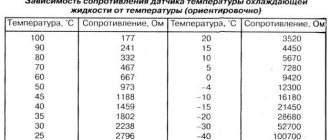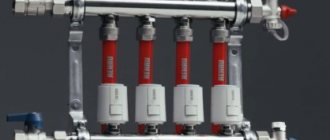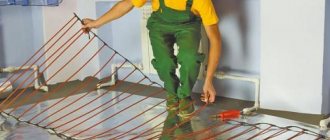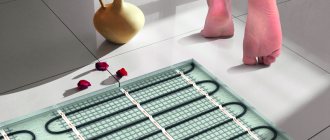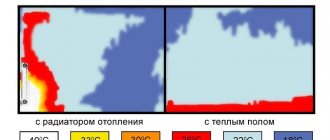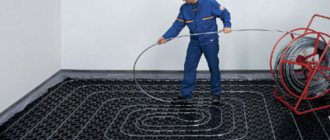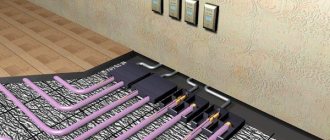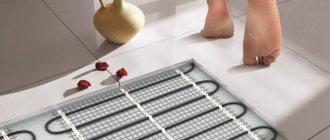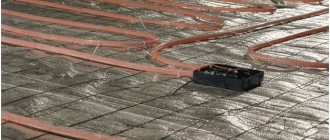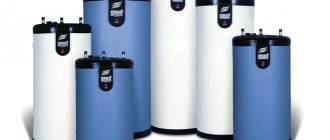- Infrared film warm floor: overview of models and installation details
- Infrared heated floor: pros and cons
- Types of infrared films
- Features of carbon and bimetallic IR films
- Technical characteristics and operational scope of film flooring
- Film heated floors Caleo
- Infrared film floors from the Rexva brand
- Features of IR films from Heat Plus
- Warm floor infrared film Monocrystal
- Infrared heated floors: consumer reviews
- Drawing up a connection diagram for a film heated floor
- Preparing the base for laying infrared film
- Features of laying film heated floors under laminate
- Installation of infrared heated floors under tiles
- Features of installing film heated floors under linoleum
- Prices for infrared heated floors
- Video: installation of Caleo underfloor heating under laminate and linoleum
Infrared film warm floor: overview of models and installation details
Previously, installing infrared flooring was considered a luxury, however, today this method of heating rooms has gained wide popularity. Film heated floors are a modern and practical option for organizing primary or additional heating in a room. In this article we will look at the benefits of installing infrared film, its types and compatibility with floor coverings.
Which electric heated floor is better: advantages, types, how to choose (read more)
Thanks to infrared film heaters, an economical and efficient underfloor heating system can be built in a matter of hours.
IR film floors: design, advantages and disadvantages
The mechanism of action of IR thermal film can be considered using the example of the construction of carbon strips grouped into sections.
Carbon paste is sealed in polyester or polypropylene film. Electricity is supplied to the carbon fiber via conductive copper and silver buses located at the edges of the film. When current passes through the carbon strip, heat is released.
Sections can be cut along dividing strips. Typically the width of the rolls is from 0.5 to 1 meter. The film is available in different thicknesses. Minimum - 0.2 mm, maximum - 2 mm.
The characteristics of film heated floors make it possible to combine it with almost all floor coverings. It is enough to roll out a plastic film for insulation, and you can lay parquet, laminate, or lay tiles on top using adhesive for heated floors.
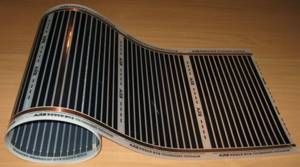
IR floors are ideal for wood floors. The wood heats up evenly, which means it does not deform or crack.
Experts have different opinions when it comes to the possibility of laying IR film under cement screed or tile adhesive. Most masters claim that it will collapse. Rather, the question here is about the different quality of the film.
If you need to roll out carpet on top, then the construction “sandwich” will look like this: IR film, plastic film, plywood, or any other rigid sheet material, carpet.
As for linoleum, the design will look the same, but you need to take into account the manufacturer's recommendations. Not all linoleum is suitable for heated floors, as there is a high risk of deformation.
Infrared heated floor: pros and cons
Heating using IR film has many advantages over other types of similar heating. Let's consider the main advantages of this heating design:
- such a system cannot fail at the same time, since it is connected in parallel;
- possibility of installation on any type of surface - both horizontal and vertical, as well as on elements that are located at an angle;
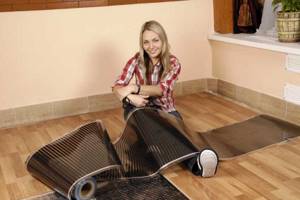
The film does not contain components hazardous to human health and does not produce unpleasant odors or toxic fumes.
- The design features of the infrared floor make it possible to achieve uniform heating of the room. This is especially important if laminate is used as a floor covering;
- another advantage of such a system is ease of installation;
- possibility of disassembly if necessary;
- this film is suitable for installation in rooms where the humidity level exceeds the permissible parameters;
- compatibility with different flooring options;
- installation of such a system is allowed not only in enclosed spaces, but also in open conditions (for example, on a veranda);
- high heat transfer coefficient, which reaches 97%;
- The efficiency of film infrared flooring is approximately 30% higher than that of other underfloor heating systems. The prices of film heated floors fully correspond to their effectiveness.
On a note! When choosing IR film for organizing floor heating, you need to take into account one very important parameter - the height of the ceilings. The lower the ceiling height, the more efficient the heating of the room.
However, this design also has some disadvantages, among which are the following:
- the need to follow clear rules when connecting;
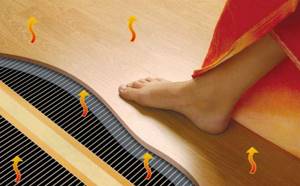
Unlike other heating systems, infrared floors act directly on the surfaces of heated objects and do not dry out the air in the room at all.
- high inertia, due to which heating and cooling occur very quickly;
- poor resistance to mechanical stress in comparison with a tubular structure that uses water as a coolant.
The film system is generally not suitable for installation as the main heating system. It is recommended to use an infrared design for additional heating.
No. 4. Safety of film heated floors (fire)

Photo from the site https://homemasters.ru/forums/topic/30943-opyt-ispolzovaniya-teplogo-pola-caleo/. Discussion of the problem of fire of film heated floors
No matter how much manufacturers praise their products and declare their safety, consumer reviews from time to time appear online containing photos of heated film floors that have caught fire. And we are not talking about a fire in the wiring, but about a fire in the heating mat itself.
The manufacturer, represented by a consumer technical support specialist, often refers to non-compliance with the installation rules specified in the technical documentation for the product. Often mentioned:
- Incorrect installation of temperature sensor;
- Insufficient heat transfer . The gap between the floor and the object too (for example, furniture without legs, a carpet was laid, a rag was forgotten on the floor, or a pet simply fell asleep in a warm place). Significant restrictions are imposed on the subsequent rearrangement of furniture, the use of carpets and other coverings, etc. ;
- lack of grounding . In many Soviet-built apartment buildings, there is no grounding from the moment the building was designed. Accordingly, it seems impossible to fulfill the requirements for grounding heated floors and all responsibility falls on the consumer.
- There are also recommendations for installing reliable thermostats . But the concept of “ reliability ” is not applicable to fire safety. You should only trust the term “ 100% safe ,” which you probably won’t find on the packaging or in the accompanying documentation for the product.
- Mandatory installation of automatic de-energization when the load in the heated floor circuit increases. Only a specialist can make the correct calculation of such a system; however, this system will only reduce the risk, albeit significantly, of electric shock or fire.
What conclusion can be drawn from this?
- Installing and operating film heated floors is not at all a safe undertaking, and in the vast majority of cases, the responsibility will fall on the consumer .
- Installation and operation of electric heated floors in rooms with high humidity increases the likelihood of a dangerous situation for the health and life of a living being. If you pay attention to some of the technical improvements actively advertised by manufacturers, it is not difficult to notice the appearance of new elements in the design of electric underfloor heating systems, for example anti-spark mesh . This indicates that the manufacturer has improved the safety of its products. But on the other hand, the manufacturer somehow did not pay attention to this and there is no guarantee that the approach to informing the consumer will change.
- The material floor covering must be 100% non-flammable , be dielectric , be sealed , and have sufficient thermal conductivity under real operating conditions (tea, water, a bottle of solvent or nail polish remover have been spilled). Those. coatings such as laminate, cork, wood, linoleum already make us think about their use with a system of electric heated floors. Ceramic tiles, porcelain tiles and similar materials look most advantageous
- Installation of electric heated floors must be carried out in strict compliance with the documentation supplied by the manufacturer of the specific product. At the same time, read the documentation before purchasing to ensure that your capabilities (for example, grounding) match the manufacturer’s requirements . All this requires time, knowledge and experience, therefore, it is wiser to entrust it to a specialist.
- It is probably worth choosing a specialist of responsibility assumed , regarding in the event of any problems arising related to the functioning and safety of the underfloor heating system.
- From a safety point of view, it is better to pay attention to models with 12V power supply . The lower the voltage, the safer it is for humans. “However, in the presence of dampness, the resistance of the human body decreases sharply and voltage only below 12 V can be considered safe.”
Types of infrared films
From a design point of view, all IR films are similar and have a common operating principle. However, for various types of premises and operating conditions, it is customary to use certain options for film heated floors. The differences between ICs are primarily due to the fact that they are produced by different companies.
Let's consider the types of IR film based on maximum heating temperature and their compatibility with various floor coverings:
- high-temperature infrared heated floors under tiles. The maximum heating temperature of such systems reaches 50°C. They are incompatible with floor coverings that are more susceptible to heat (linoleum, laminate);
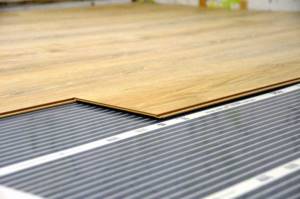
In their structure and principle of operation, all infrared films are similar to each other, the main difference is the maximum heating temperature.
- low-temperature infrared heated floors for linoleum and laminate. Such systems can heat up to 27°C;
- universal IR systems that are compatible with all types of floor coverings.
The second parameter by which IR films are classified is the type of heating element. Today, there are two main types of infrared floors, depending on the heating element:
- carbon;
- bimetallic.
The power density of the infrared floor is the last indicator, which is very important when choosing heating. Let's consider three main types of IR films, depending on this parameter:
- with low power (130–160 W/m²) - used in cases where it is necessary to organize heating of a room with a small area. Compatible with “light” floor coverings;

Infrared films from different manufacturers may differ in their appearance and technical parameters.
- with average power (from 170 to 220 W/m²) - installed in more spacious rooms. Perfect for the following flooring options: porcelain stoneware, tiles;
- with high power (above 220 W/m²) – installed in industrial buildings. They are also used for floor heating in saunas and various workshops.
If necessary, you can always contact specialists who will help you choose the necessary system for a particular case. It is also recommended that before purchasing, read the relevant reviews on specialized forums. Film heated floors are an innovative solution for any room, allowing you to achieve maximum comfort.
No. 5. What to look for when choosing?
When purchasing film infrared heated floors, it is important to pay attention to the name of the manufacturer, the stated characteristics and appearance of the film. What should a high-quality film look like and what performance qualities should it have? When choosing, pay attention to the following parameters:

- power , which directly determines what kind of floor covering the film can be used with. The power consumption of the system ranges from 130-450 W/m2. For installation under linoleum, carpet and other light floor coverings, a film with a power of up to 160 W/m2 will be sufficient; for tiles and porcelain stoneware it is better to take a more powerful film - up to 220 W/m2, and everything that is more intended for use in industrial conditions and infrared saunas;
- The thickness of the film depends on the thickness of the polymer and carbon layers; it ranges from several microns to several millimeters. The minimum permissible thickness is 0.3 mm; the generally accepted thickness is 0.338 mm. The greater the thickness, the more durable the protective shell will be and resistant to deformation. Some manufacturers insist that the film should be as thin as possible so as not to take away the height of the room, but the difference in height when installing a film of 0.3 and 3 mm will be imperceptible, and the durability of the latter will be many times higher;
- film width. The material is produced in rolls with a width of 50, 60, 80 and 100 cm. During installation, the film is mounted so that adjacent sections are as close as possible to each other, but do not overlap one another. Based on this rule and the parameters of the room, the most suitable roll width is selected to ensure the fastest possible installation and minimize waste;
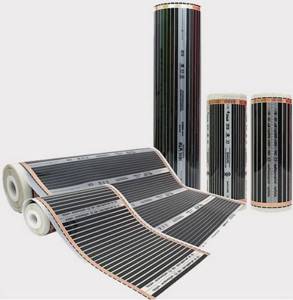
- strips made of silver and copper alloys must have clear contours, not show through, and be free from damage and signs of oxidation. The higher the silver content, the more durable and less sparkling the film will be. The silver part can be 1.5-2 mm wider than the copper part;
- preference should be given to those films where the copper and silver busbars are connected by a “dry” contact, which allows minimizing the thickness of the air gap and extending the service life of the product;
- The width of the copper bus must be at least 13-15 mm, otherwise we can talk about the low quality of the film. Carbon strips will not be visible or felt through copper;
- The carbon layer must be applied evenly and not show through. The thicker its layer, the longer the film will last;
- some manufacturers add silver in carbon pasteto minimize its current resistance and improve contact with the bus. Over time, a cold tire Maybe peel off from the constantly heated carbon part, and the result may be sparking and reduction in heating power. Large companies that are constantly improving their products are coming up with different ways to avoid sparks. Most efficient development — arrangement of a grid of silver strips at the border of the carbon coating and the copper busbar. This configuration is called anti-spark mesh;
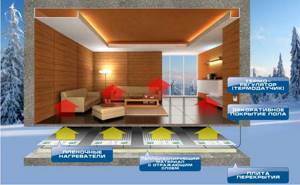
- the spaces between the carbon strips can be transparent or cloudy - the difference is in the manufacturing features. The first option is obtained by using adhesive technology, the second by lamination . After a few months of use, adhesive strips become brittle, but laminated strips last for years , so give preference to them;
- The heating speed of high-quality infrared film is 5-10 seconds.
Features of carbon and bimetallic IR films
Carbon films used for underfloor heating are more expensive. The heating elements in such a system are made of a special carbon material, which has a fibrous structure. In some cases, they are equipped with a protective layer of graphite. Spraying of this material helps to increase the strength characteristics of the system and also affects the length of its service life.
The basis of the material is represented by lavsan film. Carbon infrared film flooring can be mounted on horizontal and vertical surfaces.

Scheme of bimetallic infrared film for heating.
On a note! When installing carbon film for a heated floor, the choice of connection diagram is very important. In such a situation, experts recommend using a parallel connection option.
Bimetallic IR film differs from carbon film in that it has heating elements consisting of two metal layers (aluminum and copper). The material is based on double polyurethane film, which has good elasticity.
The installation of a bimetallic system is complicated by the fact that a ground electrode cannot be connected to the system. Also, the bimetallic structure is incompatible with ceramic flooring. It belongs to the low-temperature variety, so its recommended heating level does not exceed 27°C.
Features of different types of infrared floors
The production of infrared floors is constantly being improved. Manufacturers are trying to take into account consumer preferences. According to the type of construction, IR floors are:
- film;
- rod-shaped.
Film, in turn, are divided into solid and striped, according to the type of carbon fiber applied, which is the source of infrared radiation. The film with continuous carbon fiber coating is easy to install and easy to cut. It transfers heat from the entire area, the heating dynamics are higher than when applying carbon in strips.
The carbon strips are arranged in groups, between which cuts can be made. Since the connection to the power source is parallel, if any unit fails, the remaining area of the “stripe IR film” will remain operational.
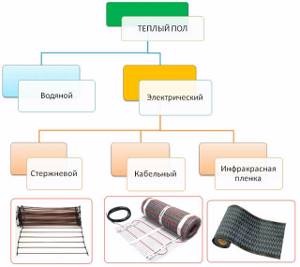
In this case, a film with a continuous coating is more advanced, since only the places where there is a tear or a cut fail. The service life and price of solid carbon film are higher than that of striped film.
The IR rod floor looks like a rope ladder. Many rods, which are filled with carbon, copper and silver, are connected to each other by wires. The rod mat has the ability to self-regulate. Its installation differs from the film type in that installation requires a “wet” cement screed. However, the service life is even higher than that of solid film, and it is not afraid of heavy mechanical loads.
Technical characteristics and operational scope of film flooring
Before purchasing IR film, it is imperative to study all its main technical characteristics. This knowledge will help you select the required type of system and calculate it for a specific room. Let's consider the characteristics of such heating structures:
- IR film is produced and sold in rolls, the length of which reaches up to 100 m. The width of the roll can be different (from 50 to 100 cm), and its weight is approximately 55 kg;
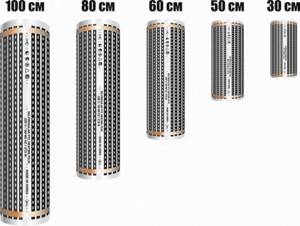
Rolls of IR film come in different widths - from 50 cm to 1 m, their thickness can be from several microns to several millimeters.
- the finished structure is powered from the electrical network, the voltage of which is standard 220V;
- per day, the IR floor consumes approximately 20 to 70 W/m²;
- the speed of heating the film to the maximum temperature is quite high (about 2 minutes);
- surface temperature can reach 50°C.
If you decide to use such a film as the main heat source, then you need to remember that it must cover at least 70% of the floor area. In regions with cold climates, film electric heated floors can only be used as additional heating.
Technical characteristics of infrared heated floor film
• power supply 220 V with errors ±22 units, 50 Hz;
• heat flow efficiency is 93-95%;
• the temperature of the heated surface depends on the power (150W – up to 45°C; 220W – up to 60°C; 400W – up to 80°C);
• tensile strength indicator – 0.15 mp/cm2;
• power consumption per 1 m2 does not exceed 30-35 W/h;
• melting temperature of the material – 130-260°C;
• radiation length varies in the range from 7 to 20 microns;
• surface heating rate – 2-4 minutes;
• practically no electromagnetic field radiation is observed.

Film heated floors Caleo
Caleo has a wide range of infrared films for underfloor heating, making it easy to choose the right system for a specific situation. The products of this brand are represented by both simple options and ultra-modern film coatings, the operation of which is as automated as possible.
Today this company produces 4 main modifications of infrared film systems.

Caleo IR film is sold complete with an installation kit: contacts and bitumen insulation, some also include connecting wires.
LINE. An inexpensive system that is perfect for installation in small spaces.
GRID. A product belonging to the middle price segment. A special feature of the GRID infrared floor is the presence of an anti-spark mesh, which is made of silver.
On a note! Caleo warm floors have their own characteristics. For example, their installation should be done only using the “dry” method. They are also not suitable for installation under ceramic floor coverings.
GOLD. As in the previous case, anti-spark mesh technology is used here. And also such films can self-regulate, which allows reducing energy consumption by up to 20%.
PLATINUM. The most expensive option for infrared flooring. It is distinguished by energy-saving qualities that can reduce electrical energy consumption by 5-6 times. IR flooring PLATINUM can be installed under areas that are covered by furniture, without the danger of overheating.
All of the above models have a remote control function. Installation of Caleo heated floors is carried out without the necessary organization of screed or special adhesive coating.
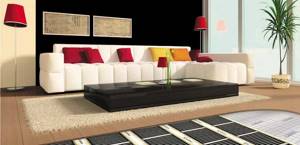
Caleo infrared film can be used as a main and additional heating system in almost all types of premises.
Preliminary calculations for floor heating
To calculate an infrared heated floor, you need to draw a floor plan on a piece of paper. Mark the places that will be filled with furniture or household appliances. Be sure to consider a convenient location for the heat regulator. It is to this that the power supply, wiring from the heating element, and also the temperature sensor are supplied.
Then you need to distribute the strips of film without overlapping them, but at the same time you need to fill the entire required area as much as possible.
Owners of IR warm film floors claim that this type of room heating can be installed independently in a very short time. And this depends not on the level of skill, but on the installation area. For example, a balcony can be insulated in 1 hour. If the floor is not in “potholes”, then no concrete work will be required.
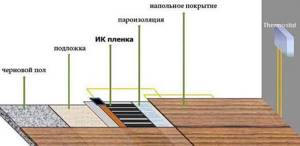
The power of an infrared heated floor is calculated taking into account whether it will remain the only heating device or will play an additional function.
In the first case, you need products with a power of 250 W/sq.m. m. If you plan to use infrared film as a support, then it is quite possible to choose a model of about 150 W/sq. m. Before starting work, you must carefully study the instructions for installation and operation of the product.
How to calculate infrared heated floors if you need to lay tiles on top? Porcelain tiles intensively absorb heat. To keep it from being cold, the film model must be of sufficiently high power, at least 220 W/sq. m.
Infrared film floors from the Rexva brand
Rexva IR films occupy second position in the ranking of heated floors. This company produces ultra-thin film communications that can be installed on various types of surfaces (vertical, horizontal and even on the ceiling). The Rexva range of heated floors is represented not only by systems with a standard power range.
For heating residential and industrial premises, this company offers infrared films, the power of which reaches 400 W/m². As a rule, such models are used to organize heating in saunas. They are characterized by a high level of water resistance, as they have a special double-sided coating located on top of the main lamination.
Products from the Rexva brand are highly durable and resistant to high pressure. Their operational scope is quite wide - from small rooms to gyms. The price of the Rexva infrared floor fully corresponds to good quality and reliability.
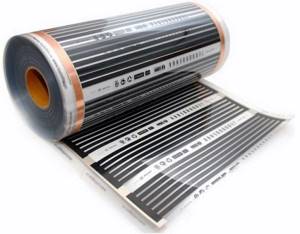
New film floors from RexVa have appeared on the market with a self-regulating effect, that is, when there is local overheating, it changes its own heat transfer in that area.
Features of IR films from Heat Plus
The Heat Plus brand produces heated floors (including infrared). The peculiarity of the models manufactured by this company is that they can have different film shapes, namely:
- striped;
- solid.
Features of the IR floor production technology from this company make it possible to avoid the presence of unheated zones. The production of such film systems involves uniform application of carbon material on a polyester base, which allows achieving a high level of efficiency of heating communications.
Let's look at other advantages of Heat Plus IR floors:
- ease of installation;
- wear resistance;
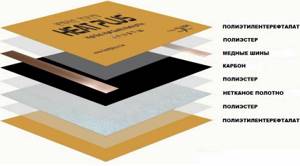
Infrared film Heat Plus consists of safe and environmentally friendly materials and is a coating with a thickness of 0.338-2 mm, consisting of 5-9 technological layers.
- reliability.
The service life of such products can reach 15 years under normal use. If desired, organizing such a system takes no more than one day, which is very convenient.
On a note! The price of IR floor Heat Plus is several times higher than the standard one. However, products from this brand pay for themselves in 1-2 years.
Overview analysis of popular models
The increasing demand for infrared heated floors is objectively influenced by the fact that many well-known companies are involved in its production.

Warm floor Kaleo, its structure
Among the assortment of high-quality models, the products of NPK Monocrystal are noted. The manufacturer offers not only heated floors, but also film baseboards, contours in the openings of windows and doors.
You can purchase an inexpensive film heated floor offered by the Russian one. The production process uses high-quality components from leading global manufacturers from Germany, Korea, and America.
Infrared floors from various Korean companies have become famous. You can have products whose products are oriented for different types of finishing coating. Terma models with a high degree of protection against electrical shock are in demand.
What are the types of electric heated floors?
Another popular Korean brand, NanoThermal, offers film floors with high resistance to aggressive substances and high temperatures. The latest developments of “Heat Plus” in this promising direction do not leave consumers indifferent. Consumers also note Enerpia infrared floors, which can easily provide heating for any living space.
Warm floor infrared film Monocrystal
The Monocrystal company is located in Ukraine and is the only manufacturer of IR floors in the CIS. Thanks to South Korean technologies used in the manufacturing process of IR films, products from this brand have taken a confident position in the construction market.
The main difference between Monocrystal models is that they do not contain silver paste. To achieve the necessary electrical contact, products from the Ukrainian brand are equipped with a thicker layer of carbon paste. In this way, stabilization is achieved between the copper busbar and the heating device.
Let's look at the main technical characteristics of Monocrystal IR floors:
- film width – from 30 to 60 cm;
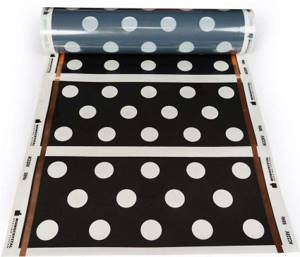
A special graphite film for tiles is produced by the Ukrainian company Monocrystal.
- step – 20–25 cm;
- powered by an electrical network with standard voltage (220V);
- maximum power indicator – up to 200 W/m²;
- The maximum heating temperature of the material reaches 50°C.
The service life of IR film from the manufacturer Monocrystal is 10 years. The model range includes the following varieties: linear, perforated, solid. Perforation is arranged for compatibility with tile flooring. Film heated floors under tiles are widely popular among buyers.
No. 6. Large manufacturers of infrared film flooring
The quality and compliance of the actual technical properties with those indicated on the packaging depends on the name of the manufacturer. Today, there are more and more different companies producing warm film floors, but many of them, unfortunately, do not offer the most durable products. When purchasing, pay attention to products from reputable manufacturers:
- Caleo is the largest company in the industry, it owns numerous innovations and developments. The manufacturer from South Korea has been producing warm film floors since 2006, and since then has become a real leader in the field.
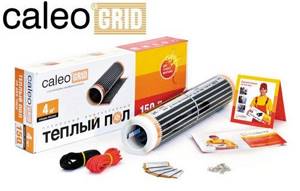
It is this company that develops floors with anti-spark mesh. Today, the range includes several modifications of heated floors: from budget to luxury options. The quality is top notch in any case, the warranty is from 7 to 15 years, there are also thermostats, cable heated floors and heating systems for roofs, pipes and drains on sale; - Heat Plus is another Korean company that, over several years of activity in Russia, has been able to make the brand recognizable and establish sales and service in many large cities. The company produces striped and solid infrared film with power from 80 to 450 W;
- TEPLOTEX is a Korean company that produces only striped film, minimum thickness 0.37 mm.

If installed correctly, the film can be used for 30 years. Roll width from 50 to 100 cm; - Rexva is a large Korean manufacturer with a market share of about 60%. The domestic buyer became acquainted with the brand’s products not so long ago, but has already managed to appreciate their highest quality. The company is also one of the leaders in terms of innovation. Due to double-sided lamination with electrical polyester, complete moisture resistance is ensured. In addition, the products can withstand high temperatures, are difficult to ignite, and do not emit acrid smoke. The film width is 50, 80 and 100 cm, thickness 0.338 mm;
- Eastec is a company from the same South Korea, where the technology of infrared heated floors was invented and where most of such products are produced today. The company offers films with a width of 30 cm and a power of 65 W, so its products will be interesting in cases where the offers of other manufacturers are not satisfactory;
- Monocrystal is a Ukrainian company that positions itself as the only manufacturer of infrared film floors in Europe and the CIS countries.
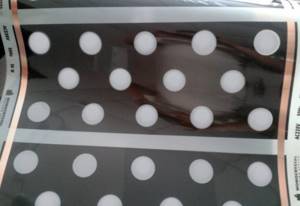
In its activities, the company combines the best Korean developments and the achievements of domestic scientists. The manufacturer has a lot of its own solutions, including a film without silver paste, but with an increased carbon layer, which suggests a more stable electrical contact. There is also a special film for tiles, which is distinguished by the presence of many holes, which improves the adhesion of the adhesive to the subfloor during tile laying. The company produces striped and continuous coatings of 60 and 34 cm with a power of 135-600 W. There is a film where the graphite coating is applied in a snake pattern, as well as products with a width of 24, 20 and even 10 cm, which can be used on balconies, for installation on the contour of doors, windows, etc.
Infrared heated floors: consumer reviews
Today, many home craftsmen refuse to install water-heated floors and give their preference to infrared floors. This is primarily due to the fact that a water system requires a longer installation time. And also its use is possible only after the screed has completely hardened. On many construction forums, consumers recommend infrared film heated floors. Reviews about these models are mostly positive.

The infrared energy emitted by carbon elements is completely identical to that emanating from the Sun, which is why it is so comfortable to be in a room with such heating.
Consumers also pay attention to the efficiency that manifests itself in the process of using such heating systems. Studying various comments, you can see that many people point to savings in energy consumption with film heated floors. Reviews talk about saving electrical energy when using such systems by up to 20%.
On a note! Some IR systems take no more than 3 hours to install and can be used immediately after installation.
Such heating communications are considered completely safe and are repairable. If individual segments of the IR system are damaged, it does not fail completely. In addition, they can be easily replaced and continued operation of the system, which is often indicated in reviews. Warm floors under laminate are in great demand and usually cost the most.
Negative comments are much less common and, as a rule, indicate that when replacing the system, it becomes necessary to dismantle the floor covering. Most often, infrared heated floors are installed under laminate. Negative reviews in this case tell us that this floor covering cools down very quickly and the heating system cannot be used as the main one.
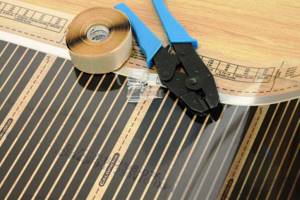
Laying and connecting film IR heaters does not require special training and can be done by hand.
The best film heated floors

The cost of 1 m2 of product is approximately 25 USD. It depends on the manufacturer, the quality of the film, and its characteristics. Therefore, to install heating in a small room with an area of 10 m2, you will have to spend $250. And this does not even take into account installation work. The price is much higher than traditional heating. This suggests that the choice of a warm film floor should be weighed.
The most popular systems today are Caleo and Daewoo. So, Kaleo, to visually depict the work of their product, placed it in an aquarium with fish. It has been equipped with a heater for several years, confirming the environmental safety of the line. Choosing a manufacturer of film heated floors is a serious matter. In this case, it is necessary to clarify whether there are the necessary certificates that can document the fire safety of the product.
The components of modern film must be well insulated and fire resistant.

So, which film is better for underfloor heating? Of course, it is impossible to give a definite answer. Everything is quite individual. Some consumers are looking for a product with higher heat output, others are looking for a cheaper product, and others are just looking for a product to follow the trend. It is important to note that reviews will tell you which film heated floor is better. By reading them, you can learn from the experience of other consumers the nuances of the functioning of certain types and the quality of products from a particular manufacturer.
Drawing up a connection diagram for a film heated floor
In order to avoid installation errors and other surprises, experts advise choosing a connection diagram and drawing up a project plan before installing IR film. An elementary diagram will help not only to correctly calculate the amount of material needed in a particular case, but also to select the film required in terms of power.
Let's consider the points that need to be taken into account when drawing up a connection diagram:
- cutting of infrared fabric is carried out strictly in those places that were marked by the manufacturer;
- It is strictly forbidden to cut at any angles and try to form shaped elements from the canvas;
- installation of the film is carried out in parallel strips;
- the strips must be laid in such a way that they do not overlap each other;
- It is important to remember that the gap between the film sheet and the furniture should not be less than 3 cm. The same distance must be maintained between the edge of the infrared sheet and the wall;
- copper bars of adjacent panels should not touch. The minimum distance between them is 1 cm;
- the number of connection points should be kept to a minimum;
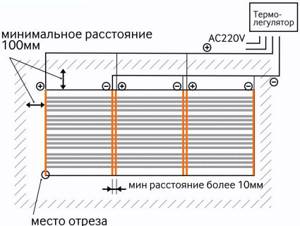
Connection diagram for a film infrared heater.
- the best option for locating the connection points is on the side of the wall on which the thermostat will be installed;
- the diagram must be drawn up in such a way that the main part of the wiring is hidden behind the baseboards;
- when using short film sections (up to 100 cm), it is necessary to take care of additional insulation and purchase additional terminal clamps.
On a note! The individual panels are joined together using adhesive tape.
The thermostat must be selected in advance, before installing the electric heated floor. Reviews about these devices can be easily studied on specialized forums on the Internet. If the area that needs to be heated is quite large, then you need to purchase additional temperature sensors.
Important points you need to know about IR film floors
With many undeniable advantages of IR film floors, there are also some negative aspects that need to be taken into account. For example, they are afraid of overheating. Therefore, they cannot be laid where you plan to install furniture that does not have legs. The space above the floor should be left at least 3 cm. You should not be afraid of this, because the free area that remains for installation will be quite enough. In addition, the design capabilities of the equipment allow, if necessary, to disconnect from the power supply the area of the floor that does not need to be heated.
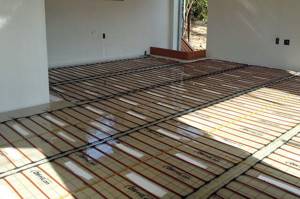
The second drawback is the still fairly high price of the heating material. This is partly compensated by the fact that for IR film floors there is no need to make an expensive and labor-intensive cement screed.
Manufacturers pay attention to observing the correct procedure for connecting the carbon film to the power source, as well as proper insulation with special adhesive plates. Consumables for assembly - electrical wiring and contact clamps - are included in the kit.
The following warning applies to any heating structures that require electricity to operate. The base for the heating element must be clean and completely dry.
Preparing the base for laying infrared film
After choosing a laying scheme and purchasing material, you can begin pre-installation preparatory work. A very important point is preparing the base for laying the infrared floor. If the old concrete screed is not even, then it must be dismantled. However, if everything is in order with the screed, it is enough to simply clean it of debris and remove dust.
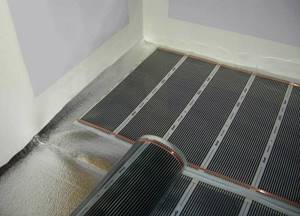
To prevent heating towards neighbors living on the floor below, it is necessary to lay heat-reflecting material for the infrared heated floor.
In most cases, the base has many small cracks and chips before laying the film. Experts advise eliminating these defects using cement mortar or any other suitable composition. In some situations, owners discover that the screed has begun to peel off from the subfloor. This situation requires the removal of the old screed and the organization of a new one.
The joints that form from connecting the walls to the floor must be carefully leveled and sealed if they have cracks. If this is not done, then the film floor will lose heat through them.
After preparing the base, it is necessary to lay thermal insulation material on the screed. As a rule, a reflector made of foamed polyethylene is used for these purposes. The joints of the individual insulator sheets are glued with mounting tape, and this is where the process of preparation for installation of the infrared heated floor ends.
Features of laying film heated floors under laminate
After completing the preparation process, you can proceed directly to installing the IR film. The installation algorithm for a heated film floor under a laminate is as follows:
- First of all, it is necessary to cut the material. The length of the strip should not be more than 8 m;

Before laying the infrared film under the laminate, it must be cut correctly.
- At the second stage, the strips are laid. In order to reduce the number of joints, experts recommend laying sheets of infrared material along a long wall. The distance from the edge of the film to the wall should be at least 10 cm, and the distance between adjacent panels should be at least 5 cm. Installation of film heated floors is best done using the parallel method;
- Next you need to connect the wires and insulate unused contacts. The wires are connected using special clamps - terminals. And for insulation, a special bitumen tape is used, which has a high sealing coefficient;
- then the infrared floor wires are connected under the laminate. To do this, you need to connect the wire to the terminal and insulate it;
- At this stage, the temperature sensor(s) are installed. Experts advise placing these elements under the second canvas (closer to the midpoint). The sensor is installed in this way: it must be glued to the underside of the canvas on the black strip;
- Next, the infrared heated floors are connected to the thermoregulatory device. To do this, you need to connect the wires from the film and the temperature sensor to it. The connection itself is made through an RCD;
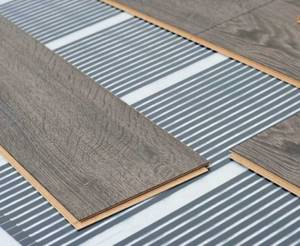
When installing IR film, you should use only special types of laminate that are designed specifically for such systems.
- Next, you need to check how the installed communication functions. To do this, a trial run is carried out;
- The last stage of installing an infrared floor involves laying the appropriate floor covering on top of it, which in this case is represented by a laminate.
On a note! The wire belonging to the sensor can be placed in corrugated protection. This will simplify the repair procedure if necessary.
It is recommended to keep it in the room for 2-3 days before laying the laminate flooring. This is necessary so that it acquires the appropriate temperature, which will further prevent its expansion. To become familiar with the features of using IR film in this case, it is recommended to read reviews on specialized websites. Film heated floors under laminate are the most common today.
Warm floors for laminate: photos, videos, instructions, installation features (read more)
Rules for laying IR heated floors
You need to follow a few simple rules for installing infrared heated floors:
- The first line of film should be located at a distance of at least 100 mm to the wall and no further than 400 mm.
- The pitch of the film cutting line is 250 mm; the film cannot be cut in other places.
- The distance between adjacent film strips should be 10 mm or higher.
- The permissible length of the floor strip is 8 m.
Under laminate
When laying film heated floors under laminate, follow the rules:
- To prevent infrared film from overheating, it must be distributed in areas where there is no furniture.
- In order for the room to be heated with maximum efficiency, the film floor must cover at least 70% of the area.
Installation diagram of IR heated floors for various types of finishing floor coverings
Next you need to draw a plan for the location of the heating elements. On paper, reflect the locations of the furniture and heating film.
Laying is done on a surface that has been leveled beforehand.
The concrete screed should not have any differences. To prevent heat from escaping from the thermal film through the floor slabs into neighboring apartments, a thermal insulating substrate (polypropylene) must be laid on the floor, the thickness of which is 3-4 mm and covered with foil on one side.
Thermal insulation strips are secured with thermal insulation tape, and they also need to be carefully trimmed around the perimeter of the room.
The heating film can only be cut in the places marked on it. They are highlighted with a dotted line and a scissors symbol.
If you cut the film diagonally, you will simply ruin it.
The distance of the film from the wall should be 10 cm.
The heating film strips are laid on the substrate one next to the other with a gap of at least 5 mm, but not more than 1 cm.
You cannot bend the heating element at an angle of 90 degrees or more, as it will stop functioning.
Connection diagram for IR heated floor
In places where the thermal film is cut and the conductive busbars are cut, it is necessary to install bitumen insulation, which is included in the heated floor kit. The contact must be installed in the center of the end of the conductive busbar and pressed well with pliers. Using a sharp knife, it is necessary to strip the current-carrying wires by 5-8 mm and clamp them with pliers in the contact terminal, then the entire contact is insulated with bitumen insulation. The infrared heated floor is connected in parallel with copper stranded wires with a cross-section of at least 1.5 mm². It is also recommended to install a temperature sensor so that the automatic floor heating works correctly.
At a distance of 20-25 cm from the wall on which you will install the thermostat, use a hammer drill to perform a groove. Place the temperature sensor into the hole formed under the heating film.
In order for the sensor to show the correct temperature, it must be placed on a heat-insulating substrate.
After all the above manipulations, the thermostat is connected.
Upon completion of installation, check the functioning of the IR heated floor. All thermal films should heat up when turned on. Only after making sure can you lay the laminate on heating elements.
Under linoleum
Laying under linoleum is similar, but has its own characteristics:
- At the first stage, prepare the base, because... The floor can only be installed on a flat and stable surface.
- The mats can be cut into 25 cm pieces. The edge is insulated with a special tape. The gap to the heating system pipes should be 30 cm.
- The film must be laid with the copper bars facing up; overlapping joints is strictly prohibited. The remaining steps are carried out in accordance with the instructions. A prerequisite for high-quality heating is the connection of a thermostat.
- Then linoleum is laid. In small rooms, the coating is laid and left for a couple of days, after which the edges are pressed against the baseboards.
There are different ways to install linoleum
When carrying out work, take into account the fact whether it will be necessary to disassemble and move the system in the future, and also pay attention to the technical characteristics of heated floors
As you can see, infrared film heated floors are an excellent option for a heating system, and its installation is not that complicated. Therefore, everything can be done with your own hands.
Installation of infrared heated floors under tiles
Laying an infrared floor under ceramic tiles can be done in two ways: “dry” and “wet”. In the first case, the heating elements of the film do not come into contact with the cement screed. In turn, the “wet” method of installing IR film is done by pouring cement mortar over the system.
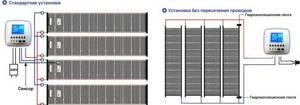
Two diagrams for connecting film heated floors under tiles.
Let's consider the algorithm of the method:
- Installation of the film sheet, which is carried out according to the same rules as in the case of organizing infrared heating under the laminate.
- Next, a protective layer is installed, which is often used as a polyethylene film.
- At this stage, it is necessary to install a base under the screed on top of the film. Plasterboard sheets (GKL) are excellent for such purposes. When fixing the sheets, special care must be taken, as there is a risk of damage to the heating elements of the infrared floor.
- Then a thin layer of screed is poured over the substrate.
- The last step is to lay the tiles. For this, standard tile adhesive is used.
In turn, laying infrared heated floors using the “wet” method is more profitable from a financial point of view. It includes the following steps:
- First of all, it is necessary to install the heating elements of the IR floor;
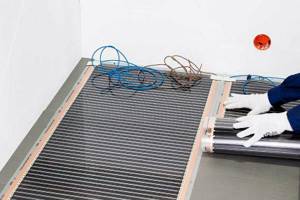
Laying the infrared film sheet under the tiles is done according to the same rules as under other coatings.
- Next, a protective polyethylene film is laid. This stage is the most important in the entire procedure of the “wet” method of installing IR. Experts recommend laying protective polyethylene film in 2-3 layers;
- At the third stage, reinforcement is installed. As a rule, a metal masonry mark is used for these purposes;
- then the screed is poured;
- Finally, ceramic tiles must be laid.
On a note! The thickness of the screed should not be more than 10 mm, otherwise the efficiency of such heating will be significantly reduced.
Thus, the installation of film heated floors under tiles can be done by hand. The only thing that is necessary for this is strict adherence to the sequence of work.

There are two ways to lay infrared film under ceramic tiles: “dry” and “wet” methods.
Warm floor under tiles: photo, video, choice of system, installation technology (read more)
What is IR underfloor heating?
Infrared heated floors can make a home more comfortable for its inhabitants thanks to the correctly selected temperature conditions.
Moreover, it can become the main type of heating if about 60% of the area of each room where heating is required is covered with carbon material.
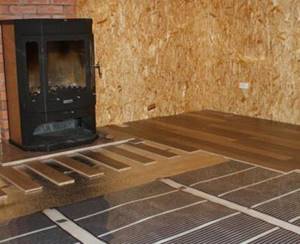
If the system is planned to be used as an additional source of comfort, then it is sufficient to install it on 40% of the usable area
Operating principle of IR heating
IR heated floors made of carbon heating elements pass current through them. As a result of this process, infrared radiation occurs in the range of 5-20 microns. It transfers its energy to objects in the room, bypassing the air. The decorative flooring and all the furniture will heat up from the radiant heat, warming the air.
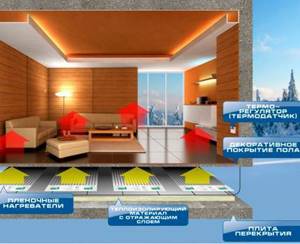
In a room with infrared heated floors, first of all, the objects located below are heated. Therefore, at the level of a person’s head, the air will be slightly cooler, which will prevent headaches.
Moreover, the floor will always be warm thanks to the film or system of rods laid underneath it. If this is the only source of heating, then you don’t have to worry about dry air. And infrared rays are not capable of burning oxygen.
An article is devoted to the actual benefits and imaginary harms of infrared radiation, which we advise site visitors to read.
Features of installing film heated floors under linoleum
Installing an infrared floor under linoleum has its own characteristics. Let's look at this process step by step:
- First, the thermal insulation material is laid.
- Next, you need to cut the IR fabric into pieces of the required length.
- At the third stage, film heated floors are installed. It is important to remember that they must be laid with the copper elements facing down.
- Then, using pliers, clamp terminals are mounted on the copper wire elements of the film.
- At this stage, the strips are fixed with double-sided tape. This is necessary in order to avoid their free movement.
- Next, you need to complete the procedure for connecting the heated film floor to the electrical network.
- After connecting the IR floor, you need to check its functionality.
- Then a protective polyethylene film is placed on the heating elements, which is fixed with tape.
- The penultimate stage takes into account the installation of the base under the linoleum. Fiberboard sheets can be used as a base.
- At the last stage, the linoleum is laid.
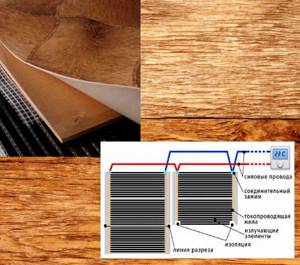
Thus, a film heated floor is installed under linoleum. If you are not confident in your own skills, then it is recommended to contact the masters who will do all the work efficiently and in a matter of hours.
The principle of connecting infrared film to a thermostat
A very important stage begins when the IR film is connected to a thermostat, which is installed on the wall. You need to connect the cables from the film to it. Under one of the strips, a recess is made in the heat-insulating material for the temperature sensor. The wires from it are also extended to the thermostat. The connection diagram for the infrared floor is included in the product instructions.
Wires need to be connected to the contacts. To do this, the bare conductor is inserted into the contact connector and carefully crimped. After the strength of the connection has been checked, it must be insulated on both sides with two pieces of bitumen insulation.
The wires are connected to the thermostat according to the diagram shown on its reverse side.
Manufacturers of IR heating devices warn that connecting the thermostat to the electrical network must be carried out by specialists in accordance with the rules and regulations for electrical installations and other technical requirements.
After this, you can carry out a test switch-on by setting the regulator to 30 degrees. After making sure that all the strips are heated and there are no sparks anywhere, you can begin installing the finished floor.
Prices for infrared heated floors
Today you can find various options for IR floors of carbon or bimetallic type. Their cost varies from 300 to 1700 rubles. per 1 m², depending on the manufacturer and technical characteristics. Some carbon models may have a special protective coating of graphite and cost up to 2000 rubles.
The dependence of the price on the company that produces IR floors can be seen with the naked eye. For example, the price of a Caleo infrared film heated floor can exceed 2,000 rubles. for 1 m², while the Rexva company sells some high-quality models for only 300–400 rubles. The price of film heated floors under laminate is the highest, which is due to high demand.
On a note! If the cost of IR is indicated for a whole roll at once, then it is recommended to recalculate the cost of 1 m2 yourself. Some companies use this method to increase the price of products.
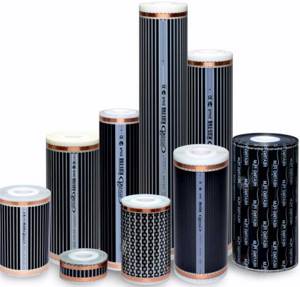
The cost of IR film for floor heating directly depends on its manufacturer.
The price of a heat-reflecting base ranges from 80 to 200 rubles. The simplest thermostat model will cost approximately 1,200 rubles, and more expensive devices equipped with touch programming will cost 2,500 rubles. The cost of installation services also differs and can vary from 200 to 400 rubles. for 1 m².
Where can I buy film heated floors? You can purchase these heating systems at any specialized store or construction hypermarket. You can also buy infrared film heated floors via the Internet. To do this, you need to go to the website that sells this product and place an order.
Connection of power wires
The connection of the cut supply wires into a single system is carried out using a VVGng installation wire, connecting sleeves in a heat-shrinkable tube and insulating material (heat-shrinkable tubes or bitumen strips), which come complete with the core floor.
The wires are fastened together using sleeves in a heat-shrinkable tube and heat-shrinkable tubes as follows:
- remove the insulation from the cut wire by about 1 cm;
- put a sleeve in a heat-shrinkable tube onto the wire;
- crimp the sleeve with pliers;
- put a heat-shrinkable casing on the installation wire;
- insert the bare end of the mounting wire into the sleeve on the other side and crimp it with pliers;
- use a construction hairdryer to heat the sleeve until it shrinks completely;
- check the strength of the connection by tugging lightly;
- slide the heat-shrinkable casing onto the sleeve;
- shrink the cambric using a hair dryer.
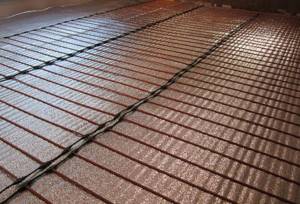
Sometimes, instead of heat-shrinkable casing, bitumen strips are used, and instead of sleeves in a heat-shrinkable tube, metal clips/contacts are used.
After assembling all the contacts, the IR rod floor is connected to the thermostat. A temperature sensor is also connected to it, which manufacturers recommend installing inside the corrugated hose, hidden in the grooved recess of the screed. This is done to access the sensor if it needs to be replaced.
After a positive test, construction of the flooring begins.

